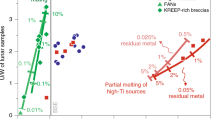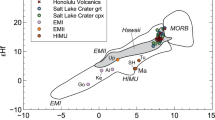Abstract
Continental crust forms from, and thus chemically depletes, the Earth's mantle. Evidence that the Earth's mantle was already chemically depleted by melting before the formation of today's oldest surviving crust has been presented in the form of Sm–Nd isotope studies of 3.8–4.0 billion years old rocks from Greenland1,2,3,4,5 and Canada5,6,7. But this interpretation has been questioned because of the possibility that subsequent perturbations may have re-equilibrated the neodymium-isotope compositions of these rocks8. Independent and more robust evidence for the origin of the earliest crust and depletion of the Archaean mantle can potentially be provided by hafnium-isotope compositions of zircon, a mineral whose age can be precisely determined by U–Pb dating, and which can survive metamorphisms4. But the amounts of hafnium in single zircon grains are too small for the isotopic composition to be precisely analysed by conventional methods. Here we report hafnium-isotope data, obtained using the new technique of multiple-collector plasma-source mass spectrometry9, for 37 individual grains of the oldest known terrestrial zircons (from the Narryer Gneiss Complex, Australia, with U–Pb ages of up to 4.14 Gyr (10–13). We find that none of the grains has a depleted mantle signature, but that many were derived from a source with a hafnium-isotope composition similar to that of chondritic meteorites. Furthermore, more than half of the analysed grains seem to have formed by remelting of significantly older crust, indicating that crustal preservation and subsequent reworking might have been important processes from earliest times.
This is a preview of subscription content, access via your institution
Access options
Subscribe to this journal
Receive 51 print issues and online access
$199.00 per year
only $3.90 per issue
Buy this article
- Purchase on Springer Link
- Instant access to full article PDF
Prices may be subject to local taxes which are calculated during checkout


Similar content being viewed by others
References
Hamilton, P. J., O'Nions, R. K., Evensen, N. M., Bridgwater, D. & Allaart, H. Sm-Nd isotopic investigations of Isua supracrustals and implications for mantle evolution. Nature 272, 41–43 ( 1978).
Jacobsen, S. B. & Dymek, R. F. Nd and Sr isotope systematics of clastic metasediments from Isua, West Greenland: identification of pre-3.8 Ga differentiated crustal components. J. Geophys. Res. 93, 338–354 ( 1988).
Bennett, V. C., Nutman, A. P. & McCulloch, M. T. Nd isotopic evidence for transient, highly depleted mantle reservoirs in the early history of the Earth. Earth Planet. Sci. Lett. 119, 299–317 (1993).
Vervoort, J. D., Patchett, P. J., Gehrels, G. E. & Nutman, A. P. Constraints on the early Earth differentiation from hafnium and neodymium isotopes. Nature 379, 624– 627 (1996).
Moorbath, S., Whitehouse, M. J. & Kamber, B. S. Extreme Nd-isotope heterogeneity in the early Archaean—fact or fiction? Case histories from northern Canada and West Greenland. Chem. Geol. 135, 213–231 (1997).
Browring, S. A., King, J. E., Housh, T. B., Isachsen, C. E. & Podosek, F. A. Neodymium and lead isotope evidence for enriched early Archaean crust in North America. Nature 340, 222–225 (1989).
Bowring, S. A. & Housh, T. B. The Earth's early evolution. Science 269, 1535–1540 ( 1995).
Gruau, G., Rosing, M., Bridgwater, D. & Gill, R. C. O. Resetting of Sm-Nd systematics during metamorphism of >3.7-Ga rocks: implications for isotopic models of early Earth differentiation. Chem. Geol. 133, 225–240 ( 1996).
Halliday, A. N. et al. Recent developments in inductively coupled plasma magnetic sector multiple collector mass spectrometry. Int. J. Mass Spec. Ion Proc. 146/147, 21–33 (1995).
Froude, D. O., Ireland, T. R., Kinny, P. D., Williams, I. S. & Compston, W. Ion microprobe identification of 4,100–4,200 Myr-old terrestrial zircons. Nature 304, 616–618 (1983).
Compston, W. & Pidgeon, R. T. Jack Hills, evidence of more very old detrital zircons in Western Australia. Nature 321, 766–769 (1986).
Maas, R., Kinny, P. D., Williams, I. S., Froude, D. O. & Compston, W. The Earth's oldest known crust: A geochronological and geochemical study of 3900–4200 Ma old detrital zircons from Mt. Narryer and Jack Hills, Western Australia. Geochim. Cosmochim. Acta 56, 1281– 1300 (1992).
Amelin, Y. V. Geochronology of the Jack Hills detrital zircons by precise U-Pb isotope dilution analysis of crystal fragments. Chem. Geol. 146, 25–38 (1998).
Patchett, P. J., Kouvo, O., Hedge, C. E. & Tatsumoto, M. Evolution of continental crust and mantle heterogeneity: evidence from Hf isotopes. Contrib. Mineral. Petrol. 78, 279– 297 (1981).
Corfu, F. & Noble, S. R. Genesis of southern Abitibi greenstone belt, Superior Province, Canada: Evidence from zircon Hf isotope analyses using a single filament technique. Geochim. Cosmochim. Acta 56, 2081–2097 (1992).
Blichert-Toft, J. & Albarède, F. The Lu-Hf isotope geochemistry of chondrites and the evolution of the crust-mantle system. Earth Planet. Sci. Lett. 148, 243– 258 (1997).
Blichert-Toft, J., Chauvel, C. & Albarède, F. Separation of Hf and Lu for high-precision isotope analysis of rock samples by magnetic sector-multiple collector ICP-MS. Contrib. Mineral. Petrol. 127, 248– 260 (1997).
Stevenson, R. K. & Patchett, P. J. Implications for the evolution of continental crust from Hf isotope systematics of Archean detrital zircons. Geochim. Cosmochim. Acta 54, 1683–1697 (1990).
Kinny, P. D., Compston, W. & Williams, I. S. Areconnaissance ion-probe study of hafnium isotopes in zircons. Geochim. Cosmochim. Acta 55, 849–859 (1991).
Patchett, P. J. Importance of Lu-Hf isotopic system in studies of planetary chronology and chemical evolution. Geochim. Cosmochim. Acta 47, 81–91 (1983).
Vervoort, J. D. & Blichert-Toft, J. Evolution of the depleted mantle: Hf isotope evidence from juvenile rocks through time. Geochim. Cosmochim. Acta (in the press).
Chase, C. G. & Patchett, P. J. Stored mafic/ultramafic crust and early Archean mantle depletion. Earth Planet. Sci. Lett. 91, 66–72 (1988).
Galer, S. J. G. & Goldstein, S. L. Early mantle differentiation and its thermal constraints. Geochim. Cosmochim. Acta 55, 227–239 ( 1991).
Taylor, S. R. & McLennan, S. M. The Continental Crust, its Composition and Evolution (Blackwell Scientific, Oxford, (1985).
Condie, K. C. Chemical composition and evolution of the upper continental crust: contrasting results from surface samples and shales. Chem. Geol. 104, 1–37 (1993).
Rudnick, R. L. & Fountain, D. M. Nature and composition of the continental crust: a lower crustal perspective. Rev. Geophys. 33, 267–309 (1995).
Vervoort, J. D. & Patchett, P. J. Behaviour of hafnium and neodymium isotopes in the crust: constraints from Precambrian crustally derived granites. Geochim. Cosmochim. Acta 60, 3717–3733 (1996).
Salters, V. J. M. & White, W. M. Hf isotopic constraints on mantle evolution. Chem. Geol. 145, 447 –460 (1998).
Vervoort, J. D., Patchett, J. P., Blichert-Tof, J. & Albarède, F. Relationships between Lu-Hf and Sm-Nd isotopic systems in the global sedimentary system. Earth Planet. Sci. Lett. (in the press).
Stern, R. A. & Bleeker, W. Age of the world's oldest rocks refined using Canada's SHRIMP: the Acasta Gneiss Complex, Northwest Territories, Canada. Geosci. Canada 25, 27– 31 (1998).
Bowring, S. S. & Williams, I. S. Priscoan (4.00–4.03 Ga) orthogneisses from northwestern Canada. Contrib. Mineral. Petrol. 134, 3–16 ( 1999).
Krogh, T. E. Improved accuracy of U-Pb zircon ages using an air abrasion technique. Geochim. Cosmochim. Acta 46, 637–649 (1982).
Krogh, T. E. Alow-contamination method for hydrothermal decomposition of zircon and extraction of U and Pb for isotope age determinations. Geochim. Cosmochim. Acta 37, 485–494 ( 1973).
Ballentine, C. J., Lee, D.-C. & Halliday, A. N. Hafnium isotopic studies of the Cameroon line and new HIMU paradoxes. Chem. Geol. 139, 111 –124 (1997).
Acknowledgements
We thank G. J. H. Oliver for providing the Acasta gneiss samples, and F. Corfu, D.Davis, U. Schaltegger, W. Mueller, F. Albarède and J. Patchett for comments on the manuscript. This work was supported by the NSERC, NSF and DOE.
Author information
Authors and Affiliations
Corresponding author
Supplementary information
Rights and permissions
About this article
Cite this article
Amelin, Y., Lee, DC., Halliday, A. et al. Nature of the Earth's earliest crust from hafnium isotopes in single detrital zircons. Nature 399, 252–255 (1999). https://doi.org/10.1038/20426
Received:
Accepted:
Issue Date:
DOI: https://doi.org/10.1038/20426
This article is cited by
-
The crystal timekeeper zircon
Nature Geoscience (2023)
-
Half-life of the nuclear cosmochronometer 176Lu measured with a windowless 4π solid angle scintillation detector
Communications Physics (2023)
-
Magma Ocean, Water, and the Early Atmosphere of Venus
Space Science Reviews (2023)
-
Multistage Formation of Neoarchean Potassic Meta-Granites and Evidence for Crustal Growth on the North Margin of the North China Craton
Journal of Earth Science (2023)
-
Early Permian bimodal magmatism and tectonic evolution of the easternmost Paleo-Asian orogenic system
International Journal of Earth Sciences (2023)
Comments
By submitting a comment you agree to abide by our Terms and Community Guidelines. If you find something abusive or that does not comply with our terms or guidelines please flag it as inappropriate.



